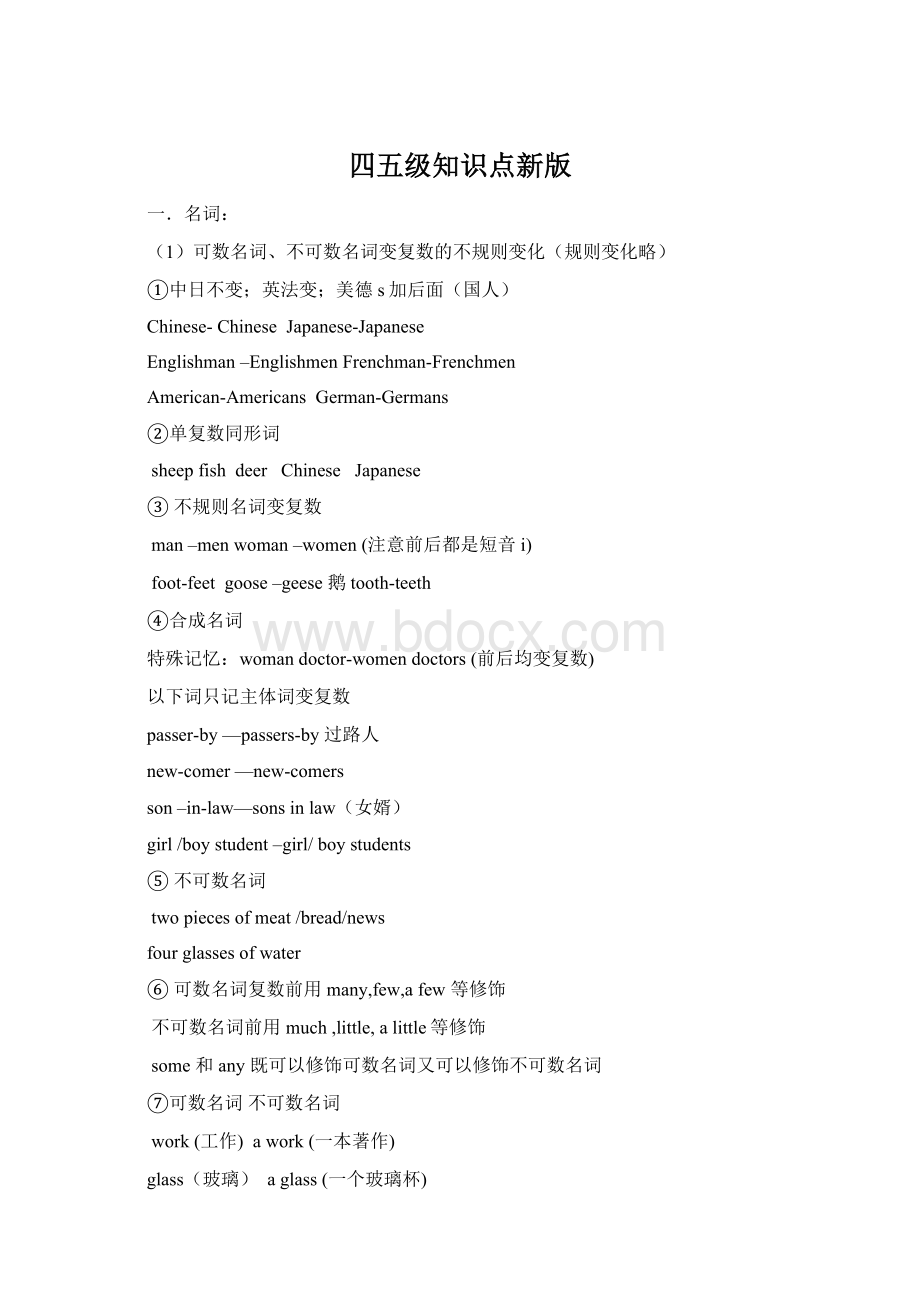四五级知识点新版.docx
《四五级知识点新版.docx》由会员分享,可在线阅读,更多相关《四五级知识点新版.docx(21页珍藏版)》请在冰豆网上搜索。

四五级知识点新版
一.名词:
(1)可数名词、不可数名词变复数的不规则变化(规则变化略)
①中日不变;英法变;美德s加后面(国人)
Chinese-ChineseJapanese-Japanese
Englishman–EnglishmenFrenchman-Frenchmen
American-AmericansGerman-Germans
②单复数同形词
sheepfishdeerChineseJapanese
③不规则名词变复数
man–menwoman–women(注意前后都是短音i)
foot-feetgoose–geese鹅tooth-teeth
④合成名词
特殊记忆:
womandoctor-womendoctors(前后均变复数)
以下词只记主体词变复数
passer-by—passers-by过路人
new-comer—new-comers
son–in-law—sonsinlaw(女婿)
girl/boystudent–girl/boystudents
⑤不可数名词
twopiecesofmeat/bread/news
fourglassesofwater
⑥可数名词复数前用many,few,afew等修饰
不可数名词前用much,little,alittle等修饰
some和any既可以修饰可数名词又可以修饰不可数名词
⑦可数名词不可数名词
work(工作)awork(一本著作)
glass(玻璃)aglass(一个玻璃杯)
paper(纸)apaper(一张试卷)
room(空间)aroom(一个房间)
(2)名词所有格
①有生命的用’s:
mymother’sbirthdayTeachers’Day教师节
没生命的用of:
thewindowoftheroom
表距离、时间的无生命的所有关系用’s:
anhour’swalk
NewYear’sDay
②TomandJerry’sroomis…(两人共有的房间)
Tom’sandJerry’sroomsare…(两人各自有的房间)
③双重所有格:
Heisafriendofmyfather’s.
他是我爸爸的所有朋友中的一个。
④表示某人的家、店铺、办公室时,常省略s后面的名词house,shop和office
atmyuncle’s=atmyuncle’shome
thedoctor’s=thedoctor’soffice
二.代词
1.人称代词
主格
宾格
2.形物代
名物代
3反身代词
I
me
my
mine
myself
we
us
our
ours
ourselves
you(你)
you
your
yours
yourself
you(你们)
you
your
yours
yourselves
he
him
his
his
himself
she
her
her
hers
herself
it
it
its
its
itself
they
them
their
theirs
themselves
形物代+名词=名物代同理other+可数名词复数=others
4指示代词六个:
thisthatthesethosesuchsame
①在电话用语中,IsthatMaryspeaking?
Whoisthat?
Yes.Whoisthat?
ThisisAnn.
②同级比较,前后成分一致。
TheweatherofBeijingiscolderthanthatofShanghai.
③Suchisourstudyplan.
Thankyouallthesame.
5不定代词:
some
any
every
no
以上四个词后面均可以加thing、body、one构成复合不定代词
some用于肯定句
注意:
疑问句表委婉Wouldyoulikesomecoffee?
any用于否定句、疑问句
注意:
肯定句表示任何一Ifyouhaveanyquestion,pleaseaskmeforhelp.
注意:
形容词放其后Eg.somethinginteresting
toomuch+不可数名词
muchtoo+形容词
anumberof+可数名词复数“许多”谓语动词用复数
thenumberof+可数名词复数“……的数量”谓语动词用单数
afew
alittle
肯定意味
few
little
否定意味
后加可数名词名数
加不可数名词
other作形容词:
other+可数名词复数=others
other作代词:
oneis…theotheris…
the表特指:
theother+可数名词复数=theothers
theother+可数名词单数theotherone
another加可数名词单数或代词
6.疑问代词
Whatdoyoulike?
你喜欢什么?
(无范围)
Whichonedoyoulikebest?
你最喜欢哪个?
(有范围)
人称排序:
you,he(she)andI单数:
二、三、一人称
we,youandthey复数:
一、二、三人称
三.数词:
序数词:
一、二、三、特殊记,first,second,third
八减t,九去e,(eighth,ninth),f来把ve替。
(twelfth)
单词ty作结尾,ty变成tie(twentieth)
twothirds三分之二
twohundredstudents二百个学生(前有数词注意单数)
hundredsofstudents成百上千个学生(后有of注意复数)
同理thousandsof数以千计的millionsof数以百万计的
四.形容词、副词
一.形容词基本位置:
1、作定语。
如:
Shanghaiisabigindustrialcity.
注意:
形容词作定语时一般在名词前,不定代词后。
如:
Ihavesomethingimportanttotellyou.
多个形容词作前置定语时,一般顺序如下:
anicebignewgreenChinesewoodenwritingdesk
冠词、物主代词、指示代词、不定代词
限定词+数词+描绘+特征+类属+用途
产地、材料
大小/长短/形状+新旧/年龄+颜色
口诀
限定描绘大长高
形状年龄和新老;
颜色国籍跟材料,
作用类别往后靠;
以ed结尾的形容词修饰人Iaminterestedinthebook.
以ing结尾的形容词修饰物averyinterestingbook
2、作表语Heisveryhandsome.
3、作宾补Wefoundhimasleeponthesofa.
4、表语形容词ill,well,asleep,afraid,aloud,alike.
5、the+形容词表示一类人:
Theseseatsareforthedisabled.
副词
1、副词的分类
1)时间副词:
before,ago,then,today,now,soon,yesterday
2)地点副词:
there,here,near,upeverywhere,outside
3)方式副词:
fast,well,hard,quickly,slowly,quietly,differently,warmly
4)频率副词:
often,always,ever,sometimes,usually,seldom,never
5)程度副词:
very,quite,so,much,rather,too,hardly,enough,almost
2、副词的用法:
可以修饰动词、形容词、副词或者整个句子。
3、副词在句中的位置。
1)时间副词和地点副词一般在句末,当表示强调时,时间副词可以放在句首。
如:
Hewillbebacktomorrow.
Tomorrowhewillbeback.
2)频度副词在实义动词前,在be动词、第一个助动词和情态动词后。
如:
Ioftensawherwalkinthepark.
Hecannevergiveupsmoking.
3)程度副词一般在被修饰的动词、形容词或副词前,在be动词、第一个助动词和情态动词后。
如:
Icanhardlybelievewhathesaid.
Iamveryhappytobewithyou.
1.规则变化
原级
比较级
最高级
构成方法
small
smaller
smallest
一般单音节词尾加-er,-est
单音节词和少数双音节词
nice
able
nicer
abler
nicest
ablest
以不发音的e结尾的单音节词和以-le结尾的双音节词只加-r,-st
easy
easier
easiest
以一个辅音字母+y结尾的改y为i,再加-er,-est
big
hot
bigger
hotter
biggest
hottest
以一个辅音字母结尾的重读闭音节双写最后一个辅音字母再加-er,-est
important
quickly
moreimportant
morequickly
mostimportant
mostquickly
其他双音节词和多音节词,在前面加more,most
部分双音节词和多音节词
可以用much,even,still,far,alot,alittle,abit,rather等词修饰比较级,
far/muchmorepopular/successfully:
far/much是副词修饰形容词、副词比较级,比较级后一般有than
2.不规则变化
原形
比较级
最高级
good/well
better
best
bad/ill/badly
worse
worst
many/much
more
most
little
less
least
old
older/elder
oldest/eldest
far
farther/further
farthest/furthest
elder表长幼older表年龄大
elderbrother兄长
farther表距离
further表程度
3.原级比较:
1)as+形容词+a+名词单数;as+many/much+名词
JohnisasgoodachildasJack.
2)倍数+as+形容词(副词)+as
TomistwiceasoldasKate.
4.比较级:
“比较级+and+比较级”表示“越来越……”
Heisgettingtallerandtaller.
“the+比较级…the+比较级”表示“越……越……”
Themorecarefulyouare,thefewermistakesyou’llmake.
5.最高级:
三者或三者以上的人或事物
…the+最高级+比较范围(in…/of…)
形容词最高级前必须加the
副词最高级前可以不加the
Tomisthetallestinhisclass./ofallthestudents.
Ijump(the)farthestinmyclass.
最高级的其他表达方式:
“比较级+than+任何其他的一个(单数)……”或“比较级+than+所有其他的(复数)……”
如:
Tomrunsfastestinhisclass.
Tomrunsfasterthananyotherstudentinhisclass.
Tomrunsfasterthananyoneelseinhisclass.
Tomrunsfasterthanalltheotherstudentsinhisclass.
五.介词
1.表时间
in在年、月、季节、世纪前in1998,inJanuary,inspring,in1990s
早上、下午或晚上inthemorning,intheafternoon,intheevening
on在节日、星期、日或具体的一天前onMay1st,onahotsummerevening,onMid-autumnDay
at在具体时刻、中午、晚上前atfive,atnoon,atnight
2.表地点
in接较大的地点inBeijing
at接较小的地点atthehotel
on表示在表面onafarm,ontheearth,ontheplayground
3.表方位
in在某地内部BeijingisintheeastofChina.(北京)
on与某地接壤NorthKoreaisonthenortheastofChina.(朝鲜)
to与某地不接壤JapanistotheeastofChina.(日本)
on树上长的Thereisanappleonthetree.
in外来物Thereisabirdinthetree.
Thereisafeatherinthehat.
on表面反义词:
beneath
above….的上面反义词below
over…的正上方反义词under
across从表面穿过acrosstheriver,street,road
through从内部穿过throughtheforest,crowd,tunnel(隧道)
六.冠词
1.a/an看是元音音素还是辅音音素
auniversityanhour
2.定冠词the的用法:
a.特指双方都明白的人或物。
b.上文提到过的人或事。
c.世上独一无二的事物。
thesun,themoon,theearth,theskyd.在方位名词前。
Intheeast
e.在序数词和形容词最高级前。
f.与形容词连用,表示一类人,如:
thepoor。
g.在某些由普通名词构成的专有名词前,如:
theSummerPalace。
h.在姓氏的复数名词前,表示一家人。
TheGreensi.表演奏乐器时乐器名词前。
playthepiano
j.用在惯用语中,如:
inthemorning。
3.零冠词的情况:
a.国名、地名、人名前,如:
China,Beijing,Jack。
b.泛指的复数名词,表示一类人或事物时。
Theyareworkers.c.在季节、月份、节假日、日期、星期等表示时间的名词前。
d.在称呼或表示官衔,职位的名词前。
President,Chairmane.在三餐、球类运动和娱乐运动的名称前。
f.当by与交通工具连用,表示一种方式时。
bytraing.序数词前有物主代词或作副词用时。
ourfirsttime
七.连词
and并列or选择but转折
While:
当…时
Whilemyfatherwasreading,mymotherwascooking.
前后都是都是持续性动词的进行时
When:
当…时
前后不必都是进行时,可持续、可瞬间。
宾语从句中if、whether表“是否”放动词后
状语从句中if表“如果”主将从现(对比记忆)
Although虽然…..(句首),后面不可以有but
Because….,……因
……………,so……果
八.动词分类
1.系动词(无被动、无进行)
①be动词amisarewaswere
②感官动词looktastefeeltouchsoundsmellseem
③变化类动词become天气变暖/冷
get天变黑,天气变暖/冷,天变长变短grow天变
turn颜色变化
keepremainstay(保持)
2.助动词:
be动词,do,does,did,has,have,had,will,shall,should,would
3.情态动词加动原:
must肯定→can可能→may有点可能可能性由强到弱
mustn’t禁止can’t不可能maynot可能不
might是may的过去式would是will的过去式
①MayI…?
表请求,否定回答用mustn’t,表示“不可以”“禁止”,不用maynot.
MayIborrowyourbike?
Yes,youmay./No,youmustn’t.
②must表推测,“一定”,用于肯定句。
否定疑问句用can/may,can’t不可能,maynot可能不。
Thereissomeoneknockingatthedoor.ItmustbeTom.
③must:
”必须,应该”,其否定回答用don’thaveto或needn’t,“不必”。
must的否定形mustn’t表“不应该”,“禁止”。
MustIdomyhomeworkrightnow?
Yes,youmust.
No,youneedn’t.
Youmustn’tplayontheroad.
4实义动词及物动词加宾语learnEnglishteachusEnglish(双宾语)
不及物动词不直接加宾语lookatyouturnoffthelight
借助介词/副词加宾语
九.动词过去式和过去分词
1.规则动词的过去式和过去分词的构成:
①:
一般动词加ed.
finish—finished;call—called.
②:
以e接尾的动词加d.
like—liked;agree—agreed.
③:
以辅音字母加y结尾的词,先将y变为i.再加ed.
study---studied;try---tried.
④:
双写情况。
stop—stopped.prefer—preferred.
2.不规则动词的过去式和过去分词的构成需要加以记忆,如go—went—gone,give—gave—given,sing-sang—sung等。
见五、六年级书中常用过去式、过去分词多积累~
原形
过去式
过去分词
cost
cost
cost
cut
cut
cut
read
read
read
beat
beat
beaten
become
became
become
run
ran
run
come
came
come
buy
bought
bought
catch
caught
caught
feel
felt
felt
find
found
found
get
got
got
keep
kept
kept
begin
began
begun
break
broke
broken
drink
drank
drunk
forgive
forgave
forgiven
take
took
taken
write
wrote
written
swim
swam
swum
十.后加todo
wouldlike,like,want,wish,hope,decide,plan
十一.后加do
Whynot/Whydon’tyou,hadbetter,wouldrather….
使役动词make(被动to还原)(五级注意)
have
let
三者均加sb.do/sth.adj.
十二.后加doing
practise,finish,enjoy,keep,bebusy,consider,mind,havefun/trouble以及介词十三.后接双宾语
bringsb.sth.=bringsth.tosb.把某物带给某人
handsb.sth.=handsth.tosb.把某物递给某人
sendsb.sth.=sendsth.tosb.把某物送给某人
takesb.sth.=takesth.tosb.把某物拿给某人
teachsb.sth.=teachsth.tosb.教某人某物
tellsb.sth.=tellsth.tosb.告诉某人某情况
booksb.sth.=booksth.forsb.为某人预定某物
get/buysb.sth.=get/buysth.forsb.为某人买某物
………………注意积累~
十四.动词的时态和语态
1.一般现在时
①经常性或习惯性的动作,常与表示频度的时间状语连用,如every…,sometimes, at…,onSunday等。
eg.Ileavehomeforschoolat7everymorning.
②客观真理,客观存在,科学事实。
eg.Theearthmovesaroundthesun.
eg.ShanghailiesintheeastofChina.
③表示格言或警句中。
eg.Pridegoesbeforeafall. 骄者必败。
④现在时刻的状态、能力、性格、个性。
eg.Idon’twantsomuch.
eg.AnnWangwritesgoodEnglishbutdoesnotspeakwell.
2.一般过去时
①在确定的过去时间里所发生的动作或存在的状态。
常用的时间状语包括yesterday,lastwe